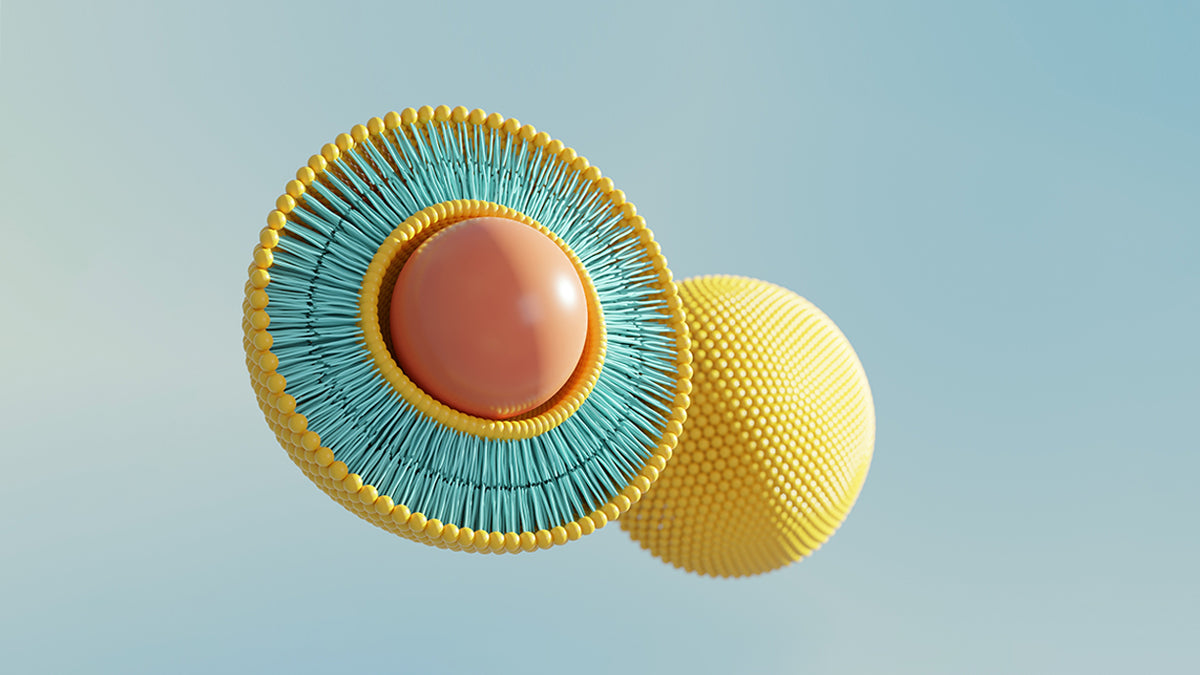A large and growing body of evidence shows that getting the right nutrition is essential for good health and promotes the prevention of chronic diseases.1 While it is widely recognised that real, unprocessed foods should always be the foundation of a healthy diet, this approach may no longer provide all the nutrients we require.
Unfortunately, due to modern agricultural practices, there has been a marked decline in the nutrient density of our foods.2, 3 Furthermore, industrialised food processing has resulted in the loss of many essential nutrients.4 We also need to account for the fact that, in this modern era, the burdens of chronic stress and unhealthy lifestyles result in increased nutritional requirements.5
Due to these dietary challenges, more and more people are turning to nutritional supplements to prevent deficiency and manage the risks associated with chronic disease.
However, when it comes to nutritional supplements, many of them are poorly absorbed and utilised. Several factors may affect bioavailability, including nutrient form, delivery method, source, stability, digestive function and nutrient competition.
Therefore, to ensure the nutrients in your supplement enter your bloodstream in a form that your cells recognise and can use quickly, it's critical that it is produced in the most bioavailable form. The challenge for supplement manufacturers is that each nutrient has its own specific requirements for optimal absorption and bioavailability.
But what if you could pack these nutrients into a microscopic bubble that is easily absorbed in the gut and delivered straight to your body’s cells?
While this may sound like science fiction, this type of nutrient delivery form, known as a liposome, is now a reality and is the most bioavailable form of supplement available.
Liposomes have been studied since the 1960s as a superior and safe form of delivery for certain drugs, but it is only relatively recently that this technology has advanced as a vehicle for nutrients.
What are liposomes?
Liposomes are composed of a double layer of phospholipids, which are the same material that makes up our cells. And, just like our cells, they can self-organise into microscopic spheres.
These phospholipids have a water-loving head and a water-repellent tail, which allow them to safely transport both fat-soluble and water-soluble nutrients through the gut wall, into the bloodstream and then release them directly into cells where they are needed. 6
This form of encapsulation ensures that nutrients are protected from degradation and destruction in the harsh environment of the gastrointestinal tract and creates a stable delivery system with enhanced absorption and improved bioavailability.7
Because they are made up of the same components as our cells, once a liposome has been passively absorbed into the bloodstream, it can then fuse with the cell membrane and deliver its contents directly into the cell.8
Enhanced nutrient delivery
Vitamin C
The benefits of vitamin C are numerous and profound. This essential nutrient plays an important role in bone formation, wound healing and the maintenance of healthy gums. It is also required for several metabolic functions including the production of hormones and neurotransmitters and is an antioxidant that protects the body from free radical damage. Vitamin C also supports the immune system, reduces the severity of allergic reactions and helps to fight off infections.9
And, because it is not stored or made by the body, we must obtain our vitamin C daily through food or supplementation.9
On average, Australian adults consume approximately 110 mg of vitamin C per day, but to achieve many of the full and optimal benefits, doses of 200 mg – 500 mg per day should be considered. 12, 13, 13, 14, 15, 16, 17
Vitamin C is relatively poorly absorbed as a supplement, ranging between 14% and 30%, depending on the supplement form.10 To overcome this, many supplements provide large doses, but taking too much only serves to further reduce the absorption rate and can result in unwanted digestive symptoms such as diarrhoea.11
This makes vitamin C an ideal nutrient for liposomal delivery.
Normally, vitamin C would be dependent on vitamin C transporters in the gut, however, when carried in a liposome, vitamin C directly diffuses into the bloodstream and bypasses this limiting step.
Liposomes also reduce vitamin C degradation in the gastrointestinal tract, slow down its release and enhance absorption. 18, 19 They also overcome any unwanted gastrointestinal symptoms, such as bloating or diarrhoea, resulting from higher doses.
These features mean that liposomes significantly enhance vitamin C bioavailability and maintain its benefits at a cellular level. 20
Vitamin D
When vitamin D was first discovered, it was primarily understood to be responsible for the absorption and mobilisation of calcium and phosphorus and its contribution to bone health.
However, over the last several decades, vitamin D3 has been recognised as an essential nutrient required for a range of critical biological functions including normal immune function, regulating mood and nervous system function as well as gut health.
As a result, deficiency is associated with a range of disease states including autoimmune diseases, allergies, osteoporosis, rickets, various cancers, infections, schizophrenia and depression. 21
To ensure adequate levels of vitamin D3 are achieved for these broad functions the Australian government recommends between 200iu and 600iu of vitamin D3 per day. However, there is growing evidence that this dose may be too low and that doses above 1,000iu per day should be considered for maintenance and up to 6,000iu per day as therapy. 22
The most natural way to get vitamin D3 is through sun exposure, but the risks and practicalities associated with regular, full-body exposure can make this difficult and problematic.
Supplementation is the next best option, but this can also come with its own set of challenges. There are several factors that can interfere with the absorption and utilisation of vitamin D3 supplements, including gut health, liver and kidney function and obesity.
Also, because vitamin D3 is fat soluble, absorption and distribution throughout the body are difficult and are dependent on the presence of required fats and proteins.
These factors can make effective vitamin D3 supplementation challenging and often result and an inability to improve deficiency states. 23
Nevertheless, recent research has shown that liposomal vitamin D3 causes a rapid increase in the blood concentration of vitamin D3 compared to standard forms. This effect was especially pronounced for people with severe vitamin D3 deficiency.24
Vitamin K2
Vitamin K2, also known as menaquinone, is an important fat-soluble vitamin that has only recently begun to gain the recognition it deserves.
Unlike vitamin K1, which is found in plants and plays a role in blood coagulation, vitamin K2 is a product of bacterial fermentation and is required for the healthy function of calcium in the body. 25
Availability of vitamin K2 from dietary sources is low globally except in a few geographic regions such as Japan due to the consumption of natto and in western Europe from fermented dairy products.26 Given this, it is likely that deficiency is common, and many people could benefit from more vitamin K2. What’s more, there is evidence that broad-spectrum antibiotics can destroy the gut bacteria that produce vitamin K2 further contributing to vitamin K2 deficiency.37
The health benefits of vitamin K2 extend to osteoporosis, cardiovascular disease, inflammation, cancer, Alzheimer’s disease, diabetes and peripheral neuropathy.
Clinical studies have unequivocally demonstrated the utility of vitamin K2 supplementation in ameliorating peripheral neuropathy, reducing bone fracture risk and improving cardiovascular health.27
Although vitamin D3 has been known as the bone vitamin, vitamin K2 has been recognised as being just as important for bone maintenance. That’s because vitamin K2 plays a pivotal role in calcium metabolism and therefore, not only promotes the calcification of bone but also prevents calcium from accumulating in soft tissues, such as the kidneys and blood vessels. 28
As a result, the combination of vitamin D3 and K2 in a single formula is considered highly worthwhile as a way of providing bone support, promoting heart health and helping boost immunity. 29
A recent study found that liposomal vitamin K2 can significantly ameliorate vitamin K2 status in people with insufficient levels.30
Nicotinamide Riboside
The name might sound complex and unfamiliar, but Nicotinamide riboside (NR) has recently become one of the most studied and exciting nutrients due to the important roles it plays in various metabolic pathways and the treatment of a wide variety of diseases.
Nicotinamide riboside is converted in the body to a chemical called NAD+. The body needs NAD+ for many processes to work normally. NR supplementation has been increasingly recognised as an effective way of increasing NAD+ levels for improved health.
Numerous studies on NR have provided evidence for a range of health benefits including improved energy metabolism, insulin sensitivity and immune function as well as repairing damaged DNA and supporting cognitive well-being. It is also being researched for its therapeutic benefits for cardiovascular, neurodegenerative, and metabolic disorders.31
And, because NAD+ levels decrease as we age, which contributes to age-related diseases, supplementation with NR is being explored for its potential in delaying the ageing process and extending lifespan.32
However, NR is not stable in circulation, degrades in plasma and disappears soon after entering the bloodstream.33
Furthermore, NR is not considered to be stable in the gastrointestinal tract and research has shown that there is significant degradation when it is exposed to simulated intestinal environments.34
This makes NR an excellent candidate for liposomal delivery to allow for rapid and efficient absorption of this molecule while avoiding breakdown in the gut. In liposome form, NR is protected from degradation in the gastrointestinal tract, liver and bloodstream.
Astaxanthin
Astaxanthin is a fat-soluble nutrient found in marine organisms and has been described as a super-antioxidant with wide health benefits. Through its antioxidant ability, astaxanthin has been reported to have several other health benefits, including anti-inflammatory activity, anti-skin-aging ability, and neuroprotective properties and has been shown to suppress cancer cell proliferation, prevent cardiovascular diseases and diabetes and promote immune system and ocular health.35
However, as a fat-soluble nutrient astaxanthin has poor solubility and has been shown to have poor bioavailability. To solve this problem, an astaxanthin liposomal formulation improves its solubility and absorption. 36
A recent study assessed the value and benefit of astaxanthin-loaded liposomes and found they enhanced the biological activities of astaxanthin and could successfully be applied as an antioxidant and anti-inflammatory ingredient. 35
Summing it all up
In the past, many nutrients were shown to have positive health benefits but were unavailable for use due to poor bioavailability. With the development of new liposomal technologies, these nutrients can now be readily accessed and utilised.
The benefits of liposomes are numerous:
- Protects against degradation in the harsh environment of the GI tract
- Increases gastrointestinal uptake and absorption
- Increases intracellular delivery
- Reduced risk of gut irritation or digestive sensitivity
- Non-invasive
- Can hold and deliver both fat-soluble and water-soluble compounds
References:
- Cena H, Calder PC. Defining a Healthy Diet: Evidence for The Role of Contemporary Dietary Patterns in Health and Disease. Nutrients. 2020 Jan 27;12(2):334. doi: 10.3390/nu12020334. PMID: 32012681; PMCID: PMC7071223.
- Montgomery DR, Biklé A, Archuleta R, Brown P, Jordan J. Soil health and nutrient density: preliminary comparison of regenerative and conventional farming. PeerJ. 2022 Jan 27;10:e12848. doi: 10.7717/peerj.12848. PMID: 35127297; PMCID: PMC8801175.
- Davis DR, Epp MD, Riordan HD. Changes in USDA food composition data for 43 garden crops, 1950 to 1999. J Am Coll Nutr. 2004;23(6):669-682. doi:10.1080/07315724.2004.10719409
- Martini D, Godos J, Bonaccio M, Vitaglione P, Grosso G. Ultra-Processed Foods and Nutritional Dietary Profile: A Meta-Analysis of Nationally Representative Samples. Nutrients. 2021 Sep 27;13(10):3390. doi: 10.3390/nu13103390. PMID: 34684391; PMCID: PMC8538030.
- Gonzalez, Michael & Miranda-Massari, Jorge. (2014). Diet and Stress. Psychiatric Clinics of North America. 37. 10.1016/j.psc.2014.08.004.
- Akbarzadeh A, Rezaei-Sadabady R, Davaran S, Joo SW, Zarghami N, Hanifehpour Y, Samiei M, Kouhi M, Nejati-Koshki K. Liposome: classification, preparation, and applications. Nanoscale Res Lett. 2013 Feb 22;8(1):102. doi: 10.1186/1556-276X-8-102. PMID: 23432972; PMCID: PMC3599573.
- He H, Lu Y, Qi J, Zhu Q, Chen Z, Wu W. Adapting liposomes for oral drug delivery. Acta Pharm Sin B. 2019 Jan;9(1):36-48. doi: 10.1016/j.apsb.2018.06.005. Epub 2018 Jun 20. PMID: 30766776; PMCID: PMC6362257.
- Sharif Mohammad Shaheen, Fazle Rabbi Shakil Ahmed , Md. Nazir Hossen , Maruf Ahmed , Md. Shah Amran and Md. Anwar-UL-Islam , 2006. Liposome as a Carrier for Advanced Drug Delivery. Pakistan Journal of Biological Sciences, 9: 1181-1191.
- Chambial S, Dwivedi S, Shukla KK, John PJ, Sharma P. Vitamin C in disease prevention and cure: an overview. Indian J Clin Biochem. 2013 Oct;28(4):314-28. doi: 10.1007/s12291-013-0375-3. Epub 2013 Sep 1. PMID: 24426232; PMCID: PMC3783921.
- Yung S, Mayersohn M, Robinson JB. Ascorbic acid absorption in humans: a comparison among several dosage forms. J Pharm Sci. 1982;71(3):282-285. doi:10.1002/jps.2600710304
- Bsoul SA, Terezhalmy GT. Vitamin C in health and disease. J Contemp Dent Pract. 2004;5(2):1-13. Published 2004 May 15.
- Australian Bureau of Statistics (ABS). Australian Health Survey: Nutrition First Results - Foods and Nutrients, 2011-12. Canberra: ABS; 2014 May 9. Report No.: 4364.0.55.007.
- Huijskens MJ, Walczak M, Koller N, et al. Technical advance: ascorbic acid induces development of double-positive T cells from human hematopoietic stem cells in the absence of stromal cells. J Leukoc Biol. 2014;96(6):1165-1175. doi:10.1189/jlb.1TA0214-121RR
- Mark Levine, Yaohui Wang, Sebastian J. Padayatty, and Jason Morrow, A new recommended dietary allowance of vitamin C for healthy young women, 2001, Proceedings of the National Academy of Sciences, AID - 10.1073/pnas.171318198 [doi], PMID – 11504949, 4099 - https://www.pnas.org/doi/abs/10.1073/pnas.1713181984100 - https://www.pnas.org/doi/full/10.1073/pnas.171318198
- Uwe Gröber and Michael F. Holick, The coronavirus disease (COVID-19) – A supportive approach with selected micronutrients, International Journal for Vitamin and Nutrition Research (2021), 92, pp. 13-34https://doi.org/10.1024/0300-9831/a000693.
- Cosgrove MC, Franco OH, Granger SP, Murray PG, Mayes AE. Dietary nutrient intakes and skin-aging appearance among middle-aged American women [published correction appears in Am J Clin Nutr. 2008 Aug;88(2):480]. Am J Clin Nutr. 2007;86(4):1225-1231. doi:10.1093/ajcn/86.4.1225
- Levine M, Dhariwal KR, Welch RW, Wang Y, Park JB. Determination of optimal vitamin C requirements in humans. Am J Clin Nutr. 1995;62(6 Suppl):1347S-1356S. doi:10.1093/ajcn/62.6.1347S
- Hickey, S., Roberts, H.J., and Miller, N.J., 2008. Pharmacokinetics of oral vitamin C. Journal of nutritional & environmental medicine, 17(3), 169–177.
- Wechtersbach, L., Poklar Ulrih, N., and Cigic, B., 2012. Liposomal stabilization of ascorbic acid in model systems and in food matrices. LWTfood science and technology, 45(1), 43–49.
- Łukawski M, Dałek P, Borowik T, et al. New oral liposomal vitamin C formulation: properties and bioavailability. J Liposome Res. 2020;30(3):227-234. doi:10.1080/08982104.2019.1630642
- Holick MF. Vitamin D: a d-lightful solution for health. J Investig Med. 2011 Aug;59(6):872-80. doi: 10.2310/JIM.0b013e318214ea2d. PMID: 21415774; PMCID: PMC3738435.
- Bleizgys A. Vitamin D Dosing: Basic Principles and a Brief Algorithm (2021 Update). Nutrients. 2021 Dec 10;13(12):4415. doi: 10.3390/nu13124415. PMID: 34959969; PMCID: PMC8709011.
- Ramasamy I. Vitamin D Metabolism and Guidelines for Vitamin D Supplementation. Clin Biochem Rev. 2020 Dec;41(3):103-126. doi: 10.33176/AACB-20-00006. PMID: 33343045; PMCID: PMC7731935.
- Dałek P, Drabik D, Wołczańska H, Foryś A, Jagas M, Jędruchniewicz N, Przybyło M, Witkiewicz W, Langner M. Bioavailability by design - Vitamin D3 liposomal delivery vehicles. Nanomedicine. 2022 Jul;43:102552. doi: 10.1016/j.nano.2022.102552. Epub 2022 Mar 26. PMID: 35346834; PMCID: PMC8957331.
- Manouchehr Saljoughian, PharmD, PhD, The Emerging Role of Vitamin K2 Department of Pharmacy, Alta Bates Summit Medical Center, Berkeley, California US Pharm. 2012;37(1):HS-12-HS-14.
- Fox, P., McSweeney, P., Cogan, T., and Guinee, T. (2004). Cheese: Chemistry, Physics and Microbiology. 3rd Edition, 1. Available at: https://www.elsevier.com/books/cheese-chemistry-physics-and-microbiology-volume-1/fox/978-0-12-263652-3 (Accessed November 25, 2021).
- Jadhav Nikita, Ajgaonkar Saiprasad, Saha Praful, Gurav Pranay, Pandey Amitkumar, Basudkar Vivek, Gada Yash, Panda Sangita, Jadhav Shashank, Mehta Dilip, Nair Sujit, Molecular Pathways and Roles for Vitamin K2-7 as a Health-Beneficial Nutraceutical: Challenges and Opportunities, Frontiers in Pharmacology, Volume 13, 2022, https://www.frontiersin.org/articles/10.3389/fphar.2022.896920 DOI:10.3389/fphar.2022.896920
- Elbossaty WF. Significant influence for vitamin K on different metabolic diseases according to positive effect on levels of both vitamin D, and calcium. Arch Biotechnol Biomed. 2018; 2: 008-011. DOI: 10.29328/journal.abb.1001010
- Dalmoro, A., Bochicchio, S., Lamberti, G., Bertoncin, P., Janssens, B., & Barba, A. A. (2019). Micronutrients encapsulation in enhanced nanoliposomal carriers by a novel preparative technology. RSC Advances, 9(34), 19800–19812. https://doi.org/ 10.1039/c9ra03022k
- Nowak JK, Krzyżanowska-Jankowska P, Drzymała-Czyż S, et al. Fat-Soluble Vitamins in Standard vs. Liposomal Form Enriched with Vitamin K2 in Cystic Fibrosis: A Randomized Multi-Center Trial. J Clin Med. 2022;11(2):462. Published 2022 Jan 17. doi:10.3390/jcm11020462
- Mehmel M, Jovanović N, Spitz U. Nicotinamide Riboside-The Current State of Research and Therapeutic Uses. Nutrients. 2020 May 31;12(6):1616. doi: 10.3390/nu12061616. PMID: 32486488; PMCID: PMC7352172.
- Johnson S, Imai SI. NAD + biosynthesis, aging, and disease. F1000Res. 2018 Feb 1;7:132. doi: 10.12688/f1000research.12120.1. PMID: 29744033; PMCID: PMC5795269.
- Ling Liu, Quantitative Analysis of Redox Metabolism, January 2018, https://dataspace.princeton.edu/bitstream/88435/dsp01js956j498/1/Liu_princeton_0181D_12390.pdf
- Campbell MTD, Jones DS, Andrews GP, Li S. Understanding the physicochemical properties and degradation kinetics of nicotinamide riboside, a promising vitamin B3nutritional supplement. Food Nutr Res. 2019;63:10.29219/fnr.v63.3419. Published 2019 Nov 21. doi:10.29219/fnr.v63.3419
- Chang HI, Shao CW, Huang E, Huang KY. Development of Astaxanthin-Loaded Nanosized Liposomal Formulation to Improve Bone Health. Pharmaceuticals (Basel). 2022 Apr 18;15(4):490. doi: 10.3390/ph15040490. PMID: 35455487; PMCID: PMC9033098.
- Lee Yong Sun, Jeon Seong Hee, Ham Hyeon Joo, Lee Hee Pom, Song Min Jong, Hong Jin Tae, Improved Anti-Inflammatory Effects of Liposomal Astaxanthin on a Phthalic Anhydride-Induced Atopic Dermatitis Model, Frontiers in Immunology Volume 11, 2020, https://www.frontiersin.org/articles/10.3389/fimmu.2020.565285 DOI:10.3389/fimmu.2020.565285
- Lai Yujiao, Masatoshi Hori, Ma Yanbo, Guo Yuming, Zhang Bingkun, Role of Vitamin K in Intestinal Health, Frontiers in Immunology, Volume 12, 2022, https://www.frontiersin.org/articles/10.3389/fimmu.2021.791565, DOI=10.3389/fimmu.2021.791565




Leave a comment
This site is protected by hCaptcha and the hCaptcha Privacy Policy and Terms of Service apply.